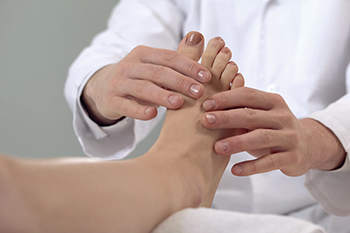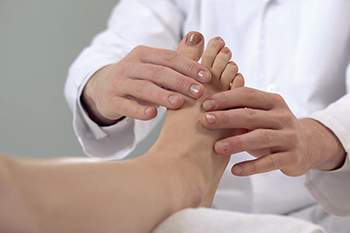
The joints in the feet can be negatively affected by the autoimmune condition known as rheumatoid arthritis. This is often referred to as RA, which is the abbreviation. The common symptoms that are often associated with this type of arthritis can include swelling, pain, and a limited range of motion. Many patients have difficulty in completing daily activities as a result of the intense pain and this can affect more than the joints. The cartilage, ligaments, and tendons may become painful and can progress quickly. Some of the foot issues that may develop from RA are bunions, claw toes, and flattened arches. Some people can have their circulation affected and this can lead to nerve damage. RA can become triggered by an existing infection, stress, and lack of sleep. This condition can produce serious complications to the feet and it is strongly suggested that you are under the care of a podiatrist who can help you to manage rheumatoid arthritis.
Because RA affects more than just your joints, including the joints in your feet and ankles, it is important to seek early diagnosis from your podiatrist if you feel like the pain in your feet might be caused by RA. For more information, contact Brian Shwer, DPM of Southaven Foot Clinic. Our doctor will assist you with all of your podiatric concerns.
What Is Rheumatoid Arthritis?
Rheumatoid Arthritis (RA) is an autoimmune disorder in which the body’s own immune system attacks the membranes surrounding the joints. Inflammation of the lining and eventually the destruction of the joint’s cartilage and bone occur, causing severe pain and immobility.
Rheumatoid Arthritis of the Feet
Although RA usually attacks multiple bones and joints throughout the entire body, almost 90 percent of cases result in pain in the foot or ankle area.
Symptoms
Diagnosis
Quick diagnosis of RA in the feet is important so that the podiatrist can treat the area effectively. Your doctor will ask you about your medical history, occupation, and lifestyle to determine the origin of the condition. Rheumatoid Factor tests help to determine if someone is affected by the disease.
If you have any questions please feel free to contact our office located in Southaven, MS . We offer the newest diagnostic and treatment technologies for all your foot and ankle needs.

Foot drop is a symptom of another condition, generally related to some form of nerve injury. It becomes apparent when a patient is unable to lift the foot enough to clear the floor or ground while walking. The foot then drags along behind, causing a type of shuffling gait. Someone with foot drop may raise the knee higher with each step, which looks like marching. Further, the foot often slaps the ground when it is lowered, as the patient is unable to control the movement. Among the many conditions that result in foot drop are a peroneal nerve injury, an ankle injury, muscular dystrophy, a stroke, or diabetes. Even something as simple as crossing the legs while sitting can constrict the peroneal nerve and cause numbness and foot drop. A podiatrist can conduct a complete examination to determine the cause of foot drop and explore the range of treatment options available to you.
If you have any concerns about your feet, contact Brian Shwer, DPM from Southaven Foot Clinic. Our doctor can provide the care you need to keep you pain-free and on your feet.
Biomechanics in Podiatry
Podiatric biomechanics is a particular sector of specialty podiatry with licensed practitioners who are trained to diagnose and treat conditions affecting the foot, ankle and lower leg. Biomechanics deals with the forces that act against the body, causing an interference with the biological structures. It focuses on the movement of the ankle, the foot and the forces that interact with them.
A History of Biomechanics
Modern technological improvements are based on past theories and therapeutic processes that provide a better understanding of podiatric concepts for biomechanics. Computers can provide accurate information about the forces and patterns of the feet and lower legs.
Understanding biomechanics of the feet can help improve and eliminate pain, stopping further stress to the foot.
If you have any questions please feel free to contact our office located in Southaven, MS . We offer the newest diagnostic and treatment technologies for all your foot and ankle needs.

The ankle is a necessary and critical part of the human body. The ankle joint allows the foot to move in different directions and makes walking and running possible. However, the ankle can be very susceptible to suffering from certain kinds of injuries. For example, broken ankles can be a serious threat to your health. Importantly, broken ankles are distinctly different from sprained ankles. When an individual breaks their ankle, the bones become essentially fractured. This is to say that bones such as the tibia, fibula, or talus can become fractured. If you have a broken ankle, you might experience several different symptoms. Commonly, an individual might experience feelings of pain or even swelling. Contrastingly, a person who sprains their ankle injures the ligaments surrounding the ankle, not the bones. When a person sprains their ankle the tissues become strained or overly stretched. Although these two injuries are different, it is possible to experience both at the same time in a very severe ankle injury. If you are worried about the health of your ankles, contact a podiatrist for more information about broken and sprained ankles.
Broken ankles need immediate treatment. If you are seeking treatment, contact Brian Shwer, DPM from Southaven Foot Clinic. Our doctor can provide the care you need to keep you pain-free and on your feet.
Broken Ankles
A broken ankle is experienced when a person fractures their tibia or fibula in the lower leg and ankle area. Both of these bones are attached at the bottom of the leg and combine to form what we know to be our ankle.
When a physician is referring to a break of the ankle, he or she is usually referring to a break in the area where the tibia and fibula are joined to create our ankle joint. Ankles are more prone to fractures because the ankle is an area that suffers a lot of pressure and stress. There are some obvious signs when a person experiences a fractured ankle, and the following symptoms may be present.
Symptoms of a Fractured Ankle
If you suspect an ankle fracture, it is recommended to seek treatment as soon as possible. The sooner you have your podiatrist diagnose the fracture, the quicker you’ll be on the way towards recovery.
If you have any questions, please feel free to contact our office located in Southaven, MS . We offer the newest diagnostic and treatment technologies for all your foot care needs.

A Morton’s neuroma refers to thickening of nerve tissue at the base of the 3rd or 4th toe. While the precise cause of this condition is unknown, it is thought to form from pressure, irritation, or injury of nerves leading to the toes. This condition can cause one to feel like there is a lump or knot near the ball of the foot, like they are walking on a pebble, or wearing socks that have become bunched up. There can be an achy, sharp, or burning pain in the ball of the foot, or tingling, numbness, or cramping in the forefoot or toes. A Morton’s neuroma can become swollen and painful. One can develop a Morton’s neuroma from wearing shoes that are too narrow where the toes are squeezed together or high-heeled shoes where the body weight is forced onto the ball of the foot. Non-invasive treatments for Morton’s neuroma include wearing properly fitted shoes, with heels less than two inches in height, wide toe boxes, and thick soles, using padding in shoes to take the pressure off the nerve, or taping the feet to redistribute body weight and ease inflammation. Medication and injections can also help relieve pain and pressure of this ailment. Custom orthotics can be made to provide support if one has an abnormal foot structure, such as flat feet or overlapping toes causing the condition. Surgery can be performed if a Morton’s neuroma becomes large or fails to be relieved with more conservative treatment options. Left untreated, a Morton’s neuroma can become worse. For this reason, it is suggested that you visit a podiatrist for a proper diagnosis and treatment that fits the severity of your specific foot problem.
Morton’s neuroma is a very uncomfortable condition to live with. If you think you have Morton’s neuroma, contact Brian Shwer, DPM of Southaven Foot Clinic. Our doctor will attend to all of your foot care needs and answer any of your related questions.
Morton’s Neuroma
Morton's neuroma is a painful foot condition that commonly affects the areas between the second and third or third and fourth toe, although other areas of the foot are also susceptible. Morton’s neuroma is caused by an inflamed nerve in the foot that is being squeezed and aggravated by surrounding bones.
What Increases the Chances of Having Morton’s Neuroma?
Morton’s neuroma is a very treatable condition. Orthotics and shoe inserts can often be used to alleviate the pain on the forefront of the feet. In more severe cases, corticosteroids can also be prescribed. In order to figure out the best treatment for your neuroma, it’s recommended to seek the care of a podiatrist who can diagnose your condition and provide different treatment options.
If you have any questions, please feel free to contact our office located in Southaven, MS . We offer the newest diagnostic and treatment technologies for all your foot care needs.

A hammertoe is a toe deformity where the 2nd, 3rd, 4th and/or 5th toe(s) bend downward at the middle joint and look like little hammers. Afflicted toes might also develop corns, calluses, and open sores due to rubbing or irritation from walking or running. Wearing shoes can be painful for those who have hammertoes and inflammation, redness, and/or a burning sensation may be felt in the toe area. Reasons hammertoes develop include wearing shoes that do not fit properly, usually those that push the toes together into a tight toe box. The toes will tighten when repeatedly bent into unnatural positions and lose their ability to stretch out. Sometimes hammertoes can occur from a muscle/tendon imbalance that leaves the toes pointing down due to structural changes in the foot that develop over a long period of time. Less often, a hammertoe results from an earlier injury or congenital defect. With early intervention, hammertoes can often be corrected with minimal treatment. Left untreated, a hammertoe can become permanent, and surgery may be required to reposition it. Treatment includes wearing comfortable, properly fitting shoes with a wide toe box, stretching feet and toes to keep muscles flexible, and wearing pads or orthotics. Further intervention, including surgery might be needed. If you suffer from a hammertoe, see a podiatrist who can properly diagnose the severity of the condition and provide correct treatment options for you.
Hammertoe
Hammertoes can be a painful condition to live with. For more information, contact Brian Shwer, DPM from Southaven Foot Clinic. Our doctor will answer any of your foot- and ankle-related questions.
Hammertoe is a foot deformity that affects the joints of the second, third, fourth, or fifth toes of your feet. It is a painful foot condition in which these toes curl and arch up, which can often lead to pain when wearing footwear.
Symptoms
Causes
Genetics – People who are genetically predisposed to hammertoe are often more susceptible
Arthritis – Because arthritis affects the joints in your toes, further deformities stemming from arthritis can occur
Trauma – Direct trauma to the toes could potentially lead to hammertoe
Ill-fitting shoes – Undue pressure on the front of the toes from ill-fitting shoes can potentially lead to the development of hammertoe
Treatment
Orthotics – Custom made inserts can be used to help relieve pressure placed on the toes and therefore relieve some of the pain associated with it
Medications – Oral medications such as anti-inflammatories or NSAIDs could be used to treat the pain and inflammation hammertoes causes. Injections of corticosteroids are also sometimes used
Surgery – In more severe cases where the hammertoes have become more rigid, foot surgery is a potential option
If you have any questions please contact our office located in Southaven, MS . We offer the newest diagnostic and treatment technologies for all your foot and ankle needs.
 Flat feet are a condition where the patient exhibits little or no arch in their feet. In other words, every part of the bottom of the foot, also known as the sole, rests entirely against the floor when standing on both feet. An individual can develop flat feet naturally as a matter of genetics, or in response to injury, aging, or pregnancy. Whatever the cause, flat feet can be a headache for runners. If you are running with flat feet, you might experience pain in the feet or knees. This may be caused by overpronation whereby some patients with flat feet excessively roll their feet inward to absorb shocks when walking or running. This possible overpronation can cause muscles in the feet to tighten. Also, flat feet might cause problems when running because the condition increases a runner’s susceptibility to suffering an injury or developing tendinitis. Tendinitis can affect the tendons around the heels and knees, essentially inflaming the tendon, which can lead to pain and tenderness. If you are a runner with flat feet, consider reaching out to a podiatrist who can help you address the problem. A podiatrist may recommend running with orthotics or shoe inserts to correct any possible overpronation.
Flat feet are a condition where the patient exhibits little or no arch in their feet. In other words, every part of the bottom of the foot, also known as the sole, rests entirely against the floor when standing on both feet. An individual can develop flat feet naturally as a matter of genetics, or in response to injury, aging, or pregnancy. Whatever the cause, flat feet can be a headache for runners. If you are running with flat feet, you might experience pain in the feet or knees. This may be caused by overpronation whereby some patients with flat feet excessively roll their feet inward to absorb shocks when walking or running. This possible overpronation can cause muscles in the feet to tighten. Also, flat feet might cause problems when running because the condition increases a runner’s susceptibility to suffering an injury or developing tendinitis. Tendinitis can affect the tendons around the heels and knees, essentially inflaming the tendon, which can lead to pain and tenderness. If you are a runner with flat feet, consider reaching out to a podiatrist who can help you address the problem. A podiatrist may recommend running with orthotics or shoe inserts to correct any possible overpronation.
Flatfoot is a condition many people suffer from. If you have flat feet, contact Brian Shwer, DPM from Southaven Foot Clinic. Our doctor will treat your foot and ankle needs.
What Are Flat Feet?
Flatfoot is a condition in which the arch of the foot is depressed and the sole of the foot is almost completely in contact with the ground. About 20-30% of the population generally has flat feet because their arches never formed during growth.
Conditions & Problems:
Having flat feet makes it difficult to run or walk because of the stress placed on the ankles.
Alignment – The general alignment of your legs can be disrupted, because the ankles move inward which can cause major discomfort.
Knees – If you have complications with your knees, flat feet can be a contributor to arthritis in that area.
Symptoms
Treatment
If you are experiencing pain and stress on the foot you may weaken the posterior tibial tendon, which runs around the inside of the ankle.
If you have any questions please feel free to contact our office located in Southaven, MS . We offer the newest diagnostic and treatment technologies for all your foot and ankle needs.

Pain, swelling, and stiffness often accompany arthritis in the feet. Many people have their toes affected by arthritis and it can be difficult to walk. Additionally, there may be a bump that forms as a result of the joints rubbing together and the toes may curl. The most common form of arthritis is known as osteoarthritis and it affects the cartilage between the joints generally causing pain and discomfort. The condition that is known as gout can cause pain in the big toe and comes from having excess uric acid in the bloodstream. This can cause crystals to lodge between the joints in the big toe and can cause debilitating pain. An autoimmune disease can cause psoriatic arthritis and typically affects the toes. Another form of toe pain can come from having an infection within the joint and this is referred to as infectious arthritis. Mild relief may be found when the shoes that are worn fit properly and it is advised to refrain from wearing high heels. If you have pain in your toes, please consult with a podiatrist who can effectively diagnose arthritis in the feet as well as offer correct treatment advice.
Arthritis can be a difficult condition to live with. If you are seeking treatment, contact Brian Shwer, DPM from Southaven Foot Clinic. Our doctor can provide the care you need to keep you pain-free and on your feet.
Arthritic Foot Care
Arthritis is a joint disorder that involves the inflammation of different joints in your body, such as those in your feet. Arthritis is often caused by a degenerative joint disease and causes mild to severe pain in all affected areas. In addition to this, swelling and stiffness in the affected joints can also be a common symptom of arthritis.
In many cases, wearing ill-fitting shoes can worsen the effects and pain of arthritis. Wearing shoes that have a lower heel and extra room can help your feet feel more comfortable. In cases of rheumatoid arthritis, the arch in your foot may become problematic. Buying shoes with proper arch support that contour to your feet can help immensely.
Alleviating Arthritic Pain
It is best to see your doctor for the treatment that is right for your needs and symptoms. Conditions vary, and a podiatrist can help you determine the right method of care for your feet.
If you have any questions, please feel free to contact our office located in Southaven, MS . We offer the newest diagnostic tools and technology to treat your foot and ankle needs.

Cellulitis is a non-contagious infection that affects the tissue underneath the skin and can impact any part of the body. It usually starts in areas where the skin has been broken in some way, however, people who have immunodeficiencies can sometimes develop cellulitis in skin that has not been broken. Although various forms of bacteria can cause cellulitis, group A streptococcus and Staphylococcus aureus are the most common. It is important to try to prevent cuts and scrapes in your child’s skin which may be difficult if they play a sport or are otherwise physically active. Protective gear such as elbow and knee pads, shin guards, and bike helmets, can help your child from breaking their skin. If they go on a hike, have them wear a long-sleeved shirt and long pants, and sandals on the beach. Call a podiatrist if you see areas on your child’s feet that are red, warm, swollen, and tender. Additional warning signs include fever, chills/sweats, or swollen lymph nodes near the affected area. Your child’s podiatrist may need to take a blood sample to make sure the infection has not spread into your child’s bloodstream.
Making sure that your children maintain good foot health is very important as they grow. If you have any questions, contact Brian Shwer, DPM of Southaven Foot Clinic. Our doctor can provide the care you need to keep you pain-free and on your feet.
Keeping Children's Feet Healthy
Having healthy feet during childhood can help prevent medical problems later in life, namely in the back and legs. As children grow, their feet require different types of care. Here are some things to consider...
Although babies do not walk yet, it is still very important to take care of their feet.
Avoid putting tight shoes or socks on his or her feet.
Allow the baby to stretch and kick his or her feet to feel comfortable.
As a toddler, kids are now on the move and begin to develop differently. At this age, toddlers are getting a feel for walking, so don’t be alarmed if your toddler is unsteady or ‘walks funny’.
As your child gets older, it is important to teach them how to take care of their feet.
Show them proper hygiene to prevent infections such as fungus.
Be watchful for any pain or injury.
Have all injuries checked by a doctor as soon as possible.
Comfortable, protective shoes should always be worn, especially at play.
If you have any questions please feel free to contact our office located in Southaven, MS . We offer the newest diagnostic and treatment technologies for all your foot and ankle needs.